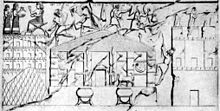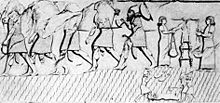Musasir
Urartu |
Muṣaṣir or Ardini ( Persian موساسیر, Urartian Ardini (probably from Hurrian arteni , city), Assyrian KUR Mu-ṣa-ṣir, Mu-ṣa-ṣi-ru / ri / a / URU Mu-ṣa-ṣi-ra-aa , Babylonian KUR Muṣāṣir ) was a country in the Zagros . The capital was the city of the same name, Muṣaṣir.
location
The exact location of the city of Muṣaṣir is not certain, although the country itself has been identified beyond any doubt. Most researchers today assume that Muṣaṣir was in the vicinity of Topzawa .
- Thureau-Dangin assumed that Muṣaṣir was in the Hakkari Mountains.
- Boehmer (see under literature) identified Mudjesir near Sidekan , 10 km west of Topzawa as Muṣaṣir. Sargon II mentioned in his annals that the land of Muṣaṣir lies in front of four high mountains. From today's Mudjesir castle ruins, four mountains can be seen that border the Schito mountain range .
- The Helsinki Atlas locates Muṣaṣir in the Rawanduz area , about 80 km northeast of Erbil .
- Reza Heidari, an archaeologist with the Cultural Heritage and Tourism Organization of West Azerbaijan, wants to identify Rabat Tepe near Sardasht in Iran with Muṣaṣir.
history
The first mention of Muṣaṣir is found under Assur-Nasirpal II , the 879 BC. On the banquet stele from Nimrud describes the inauguration of his palace in Kalḫu. For this ten-day royal festival the envoys from the countries Gurgum , Melidu , Ḫubuškia , Gilzanu , Kuma and KUR Muṣaṣirāja appeared.
The Kel-i-Schin stele , a Urartian - Assyrian bilingual from the Kel-i-Schin , a pass through the Zagros Mountains, mentions the pilgrimage of the Urartian king Išpuini and his son Minua to the Ḫaldi sanctuary in Muṣaṣir, where it reaches the god Making offerings.

Išpuini took Muṣaṣir around 810 BC. And called the city Ardini.
In the 31st year of the reign of Shalmaneser III. conquered the turtānu Dajan-Aššur 828 BC The city of Zapparia and 46 villages in the country of Muṣaṣir . Previously, King Dada from Ḫubuškia, which at that time was on the borders of Urarṭu, paid tribute . The Kurkh monolith lists Muṣaṣir among the conquests in Urartu, all other inscriptions by Sulmanu-ašared III. however, list Arzaškun instead of Muṣaṣir. Under Sargon II , Muṣaṣir was claimed by both Urarṭu and Assyria. On the stele of Topzawa , Rusa I of Urartu reports having installed King Urzana in his office, while Sargon saw him as an Assyrian vassal who refused to pay tribute (Letter from God, lines 306-308).
In his 8th palû (year of reign), i.e. 714, when Ištar-dūri was līmu ( eponymous official ), Sargon II led a campaign in the Zagros. Sargon originally wanted to bring Andia and Zikirtu under his control. Ullusunu of Mannai , according to Assyrian sources a vassal of Sargon, had asked for help against Rusa I of Urartu . Sargon defeated Rusa on Mount Uaus , sacked parts of Urartus without being able to conquer the capital and, perhaps to make up for this failure, plundered Muṣaṣir on the march back. King Urzana was captured.
Report on the campaign:
- The Epistle to Aššur ;
- The eponymous chronicle : campaign against Urarṭu, the city of Muṣaṣir, Ḫaldia ;
- The Nineveh prism : campaign against Rusa of Urarṭu, list of booty from Muṣaṣir;
- The annals of Chorsabad: Tribute of the Manneans and Medes , campaign against Urarṭu and Muṣaṣir.
The report about the taking of Muṣaṣir without a fight is the climax of God's letter. Only one driver, two horsemen and three foot soldiers lost their lives while taking Muṣaṣir. The looting of the temple and the removal of the booty, including the statues of Ḫaldi , are described. The booty is listed in detail (Letter from God, lines 309-414). In an abbreviated form, Sargon reports elsewhere:
“I defeated Rusa I of Urarṭu on the inaccessible mountain Uaus and captured 250 of his royal family. I captured and burned 55 strong walled cities of its eight territories along with eleven of its castles. […] Muṣaṣir, who had relied on Rusa from Urarṭu […] […] I covered with troops like locusts. […] Rusa […] heard that Muṣaṣir had been destroyed, that his god had been dragged away, and […] took his own life with the iron dagger of his belt. "
The list of prey is impressive:
“I received precious stones in abundance, scepter made of ivory, set in silver, the possessions and the gods of this palace, colored robes, linen robes without number. Haldi and his wife Bagmaštu (or Bagbartu), with the possession of his temple ... four talents , three mines of gold, 162 talents, twenty mines of silver, 3,600 talents of unworked copper, 27 silver objects, countless objects made of bronze and iron, a statue of the king in prayer Ištar-Duri, son of Išpuini , king of Urarṭu, his seat made of copper, with a bull made of copper, a cow made of copper and a calf made of copper I carried away with me, and I brought it to Assur. I left the remaining gods there. "
In addition, 6,210 people, 12 mules, 380 donkeys, 525 cattle, 1285 sheep, the wife, the sons and the daughters of Rusa were abducted.
In the following 9th year of reign (713) the king stayed in the country according to the eponymous chronicle, while his nobles were at war in Ellipi . Rusa appears again in the list of his enemies. That year the statue of Ḫaldi was brought back to Muṣaṣir. It is even considered that Rusa succeeded in regaining control of Musasir.
buildings
In the city of Muṣaṣir there was a tower-temple ( susi ) of the Urartean main god d Ḫaldi . The statue showed the god with his wife Bagmaštu . The names indicate an immigration of the deities and could indicate an Iranian origin.
Kings of Musasir
Cities and fortresses
- Muṣaṣir
- Sapparia
Individual evidence
- ↑ M. Boehmer, On the location of Musasir. Baghdad Communications 6, 1973
- ↑ Simo Parpola / Michael Porter (eds.), The Helsinki atlas of the Near East in the Neo-Assyrian period. Helsinki. Casco Bay Assyriological Institute 2001, 4
- ^ Brick Cuneiform Inscription Discovered in Rabat Tepe. Archaeonews, Nov. 28, 2006
- ^ M. Salvini, keyword "Muṣaṣir", Reallexikon der Assyriologie
- ^ Kathryn F. Kravitz, A last-minute revision to Sargon's Letter to the God. Journal of Near Eastern Studies 62/2, 2003, 82
- ^ Dietz-Otto Edzard: History of Mesopotamia , CH Beck, Munich 2004, p. 210.
- ↑ source
- ^ AT Olmstead, The Text of Sargon's Annals. The American Journal of Semitic Languages and Literatures 47/4, 1931, 259-280.
- ^ S. Parpola (ed.), Correspondence of Sargon II. Helsinki 1987, xix-xx
- ↑ black obelisk, 31 palu
literature
- M. Boehmer, On the location of Musasir. Baghdad Communications 6, 1973.
- Rainer Maria Boehmer / H. Fenner, research in and around Mudjesir (Iraqi Kurdistan). Archäologischer Anzeiger 88, 1973: 479-521.
- P. Dubovský, Conquest and reconquest of Muṣaṣir in the 8th century BCE '. State Archives of Assyria Bulletin 15, 2006, 141-146.
- Dietz-Otto Edzard : History of Mesopotamia , CH Beck, Munich 2004, ISBN 3-406-51664-5
- Dietz-Otto Edzard: Real Lexicon of Assyriology and Near Eastern Archeology Volume 8 , de Gruyter, Berlin 1997, pp. 444-450, ISBN 3-11-014809-9 .
- Frederick M. Fales, Narrative and ideological Variations in the Account of Sargon's Eighth Campaign. In: M. Cogan and I. Eph'al (eds.), Ah, Assyria ..., Studies in Assyrian History and Ancient Near Eastern Historiography presented to Hayim Tadmor (Jerusalem 1991), 129-147.
- K. Jakubiak, Some remarks on Sargon II's Eighth Campaign of 714 BC. Iranica antiqua 39, 2004, 191-202.
- Kathryn F. Kravitz, A last-minute revision to Sargon's Letter to the God. Journal of Near Eastern Studies 62/2, 2003, 81-95.
- CF Lehmann-Haupt, Musasir and the eighth campaign of Sargon II (714 BC), communications of the Vorderasiatisch-Aegyptischen Gesellschaft 21, 1916, 137-40;
- C. Friedrich Lehmann-Haupt, Armenia then and now, Vol. 2 (Berlin and Leipzig 1926), 310, 325.
- LD Levine, Sargon's Eighth Campaign. In LD Levine and TC Young (Eds.), Mountains and Lowlands: Essays in the Archeology of Greater Mesopotamia, Bibliotheca Mesopotamica 7 (Malibu, 1977), 135-51.
- W. Mayer, Sargon's campaign against Urartu 714 BC A military historical appraisal. Communications from the German Orient Society 112, 1980, 13–33.
- W. Mayer: Sargon's campaign against Urartu 714 BC Chr., Text and translation. Communications Deutsche Orient-Gesellschaft 115 , 1983, pp. 73–113.
- Oscar White Muscarella, The Location of Ulhu and Uise in Sargon II's Eighth Campaign, 714 BC Journal of Field Archeology 13, 1986, 465-75.
- A. Leo Oppenheim, The City of Assur in 714 BC Journal of Near Eastern Studies 19/2, 1960, 133-147.
- Horace Abram Rigg Jr., Sargon's 'Eighth military campaign'. Journal of the American Oriental Society 62/2, 1942, 130-138.
- HF Russell, Shalmaneser's campaign to Urartu in 856 BC and the historical geography of Eastern Anatolia according to the Assyrian sources. Anatolian Studies 34, 1984, 171-201.
- Hayim Tadmor, The campaigns of Sargon II. Of Assur: A chronological-historical study. Journal of Cuneiform Studies 12/3, 1958, 77-100.
- Edwin M. Wright, The Eighth Campaign of Sargon II of Assyria (714 BC). Journal of Near Eastern Studies 2, 1943, 173-86.
- K. Jakubiak, Some remarks on Sargon II's Eighth Campaign of 714 BC. Iranica antiqua 39, 2004, 191-202.
- GW Vera Chamaza, The VIII. Campaign of Sargon II: An investigation into politics and historical geography of the late 8th century. v. Chr. (Part I) ', Archaeological Communications from Iran 27, 1994, 91–118.
- GW Vera Chamaza, The VIII. Campaign of Sargon II: An investigation into politics and historical geography of the late 8th century. v. Chr. (Part II) ', Archaeological Communications from Iran 28, 1995/96, 235–267.
Coordinates: 36 ° N , 46 ° E


